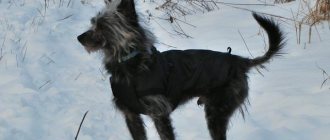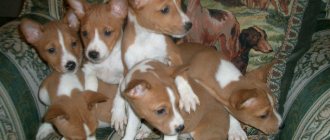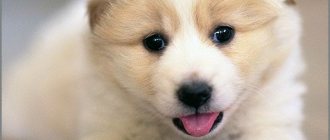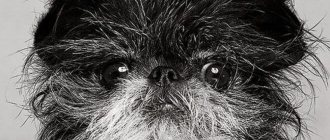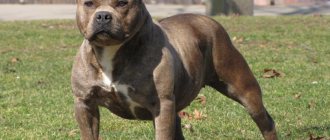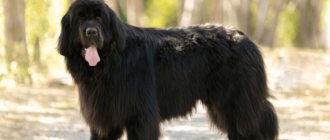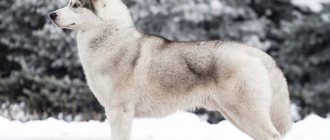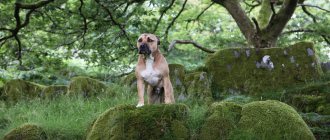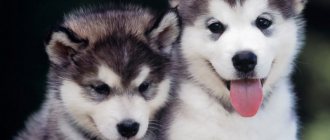- Pets
- >>
- Dog breeds
* Here is a photo of a typical representative of the Basenji dog breed . You can send us photos of your animals by email, and we will post them on the website. Don't forget to send your pet's name.
Other breed names:
African Non-Barking Dog, Congolese Bush Dog, Congo Forest Dog, Congo Terrier, Nyam Nyam Terrier, Zande Dog
Video
* We invite you to watch a video about the Basenji . In fact, in front of you is a playlist in which you can select and watch any of 20 videos about a given dog breed by simply clicking on the button in the upper right corner of the window. In addition, the material contains quite a lot of photos. By looking at them you can find out what a Basenji looks like.
In this article:
|
Rate the material!
[Total votes: 2 Average: 5]
Basenji is a breed of hunting dog from Africa. Most English clubs classify it as a hound, the American United Kennel Club places it in the greyhound group, and in the Fédération Cynologique Internationale system it is classified in the fifth group, Spitz and primitive types.
History of the Origin of the Basenji
This breed was not bred by humans, but appeared on the African continent a very long time ago. Images of a lean dog, like the extinct greyhound, are found on artifacts starting with the XII dynasty of the pharaohs of Egypt, who ruled during the Middle Kingdom in the 20th-18th centuries BC. e. They were originally kept for hunting small animals, tracking them down and driving them into nets.
The Basenji breed was described by Europeans in the Congo in 1895 and named Basenji. She is highly valued by local residents for her courage, intelligence, speed and silence. These dogs, like wild Australian dingoes, do not bark.
After the discovery and description of the breed, several attempts were made to bring the Basenji to England, but they all ended in failure, as the animals died from disease. For example, Lady Helen Nutting brought six individuals from Sudan in 23 of the last century, but they all died without even leaving the quarantine zone. Only in the 30s were they successfully brought to England, and then, by Heinrich Trefflich, to America (1941). All dogs in Europe and the USA are the ancestors of these animals.
The breed was registered with the AKC in 1943. At the request of the American Club, the AKC stud book was reopened for the Basenji in 1990, and then for selected imported dogs from January 1, 2009 to December 31, 2013. An expedition of American dog handlers collected breeding individuals in villages in the Basankusu region of the Congo in 2010. The dogs are also registered with the United Kennel Club.
Fun Fact: Basenji-like dogs are common throughout much of Africa, but the original breed stock originated from the old-growth forest areas of the Congo Basin. It was there that the structure and type of the breed were formed, adapting to the environment and during the use of animals for hunting in conditions of extremely dense vegetation.
This breed was defined as basal, that is, prior to the appearance of modern breeds. Recent DNA studies based on whole genome sequences indicate that the domestic dog is a genetic subspecies of the gray wolf.
It emerged from a now extinct population of Late Pleistocene wolves, primarily including Basenjis and dingoes. The term "basal" means a line extending at the beginning of the origin of a group, which is the basis of a branch originating from a common ancestor.
Basenji - description of the breed
Small, short-haired dogs with straight ears, highly curled tails and graceful necks. Optimal height is 43 cm for males and 40.5 cm for females. Variations of 2-3 cm with a harmonious addition are not of great importance. The optimal weight is 10.9 kg for males and 9.5 kg for females.
General appearance of the animal:
- Slim;
- The body is close to square in outline;
- Light frame;
- Aristocratic posture;
- Long legs of a slightly shortened format;
- High neck set.
Flat forehead of medium width. The forehead has pronounced wrinkles, the muzzle tapers towards the tip of the nose. There is a slightly visible transition from the forehead to the muzzle, the muzzle is chiseled, the nose is black. The eyes are almond-shaped, dark chestnut or dark brown.
The ears are set high, not large, stand upright, slightly directed forward. Shoulders are moderately laid back. The shoulder blade and shoulder are approximately the same length. The elbows are well pressed to the chest. The legs are straight, with clean fine bone, long forearm and well-defined tendons. Pasterns of good length, strong and flexible.
The paws are small, compact, oval. Dewclaws are usually removed. The tail is set high. The ischial tuberosities are located much further than the base of the tail. Sometimes it has two curls.
These dogs are athletic in build with a graceful, confident gait. They move at a double gallop, straightening their tightly curled tail at maximum speed for balance.
Popular Basenji colors
The breed standard recognizes four colors:
- Red and white;
- Black and white;
- Tricolor;
- Brindle.
All options provide specific mandatory features:
- White color does not predominate over the main color;
- Fawn spots are acceptable;
- All color spots must have clear boundaries;
- White markings are present on the chest, nose, end of the tail and on the paws.
Red-white color is a bright, rich, juicy red uniform color without impurities with clear boundaries with white zones. This is the most common basenji color and is sometimes called red and white because the base color is so bright.
The most rare one is black and white. Animals with this coloration are primarily black, which turns brick-red in the sun. White spots are located in the same place as on their red counterparts. Pure black colors are also possible, which are also called full black. Silty shades are possible for it, which appear later.
Interesting fact: Animals with a tricolor combine black, white and red, where the main color is black, with red tan markings on the face, on the cheekbones, inside the ears, above the eyes, on the chest, inside the legs and other places. White color in the same places as the red and white color, but does not predominate.
The brindle color is characterized by a series of clear, narrow stripes that are brick red and black. The more clearly they are expressed, the more valuable this coloring is. The red background can vary from red tones to dark brown with a red tint. This color standard was adopted by some FCI member countries in 2000. For exhibitions, this color is allowed only in these countries.
There are non-standard colors that are not allowed to participate in exhibitions. For example, trindle - implies a mixture of tricolor and brindle. There are also fawn and blue colors that do not meet the standards.
Black and Trindle dogs have a recessive gene, and when mated with representatives of accepted colors, they produce offspring that meet breed standards.
Tail
The tail is set very high, giving a special appearance to the hind legs. Forms a tight ring, the tip of the tail lies close to the back. The ring can consist of one curl or two. The tip may be positioned on the thigh.
Limbs
The forelegs are straight, the bones are thin. The hindquarters are strong and have well-developed muscles. The paws are located perpendicular to the ground, small, with small claws. When gait, the limbs are carried straight forward, providing long and rhythmic movements.
Coat
The coat is short and smooth, lying close to the body. The structure of the hairs is very thin. The breed is hypoallergenic, but sheds a lot. According to the standard, several types of color are allowed - one-color (black), two-color (black or red and white) and three-color (black and tan or brindle with white) suits with white markings. White should be on the paws, tip of the tail and chest, while it is optional on the neck and belly.
Character and habits of the Basenji
Basenjis are very sensitive, alert, energetic, curious, wary of strangers, affectionate with family members, and friendly with children. These pets tend to become emotionally attached to one person. They get along well with other dogs, they can find a common language with domestic cats in the family, but on the street they enthusiastically begin to hunt them.
They do not get along with other pets: hamsters, rats, guinea pigs, birds, perceiving them as prey. In the same way, any living creature on the street is perceived by the dog as an object for hunting, and the prey will be brought to the owner in a low way.
Interesting fact: Basenjis do not like rainy and damp weather and are strongly opposed to such walks, but they love to climb fences and overcome obstacles.
The character of this dog is cheerful and cheerful. She brings many joyful moments to the family, but at the same time the animal is very independent. The dog is easy to train, although due to its lively nature it cannot concentrate on training for more than 10 minutes. In order for an animal to correctly carry out commands, it must understand why it needs to be done and recognize the owner as an absolute leader. Suppression of character, cruel and rude behavior can result in a timid, withdrawn or stubborn, aggressive animal.
The Basenji has a lot of intelligence, curiosity and perseverance. He, like a cat, can climb onto a table or cabinet to get a hidden treat and will not do this during the day, but will wait until night or when all the owners leave the apartment. They can be amazingly resourceful in achieving their goals. And if he cannot escape from the apartment, then in a private house he needs to be vigilant, since a low fence or holes in the fence will allow him to freely go out to explore the surroundings.
To spend their irrepressible energy with dogs, you need to walk a lot, go jogging together, and, if possible, go out or go into nature. This dog is a good friend and partner, an excellent hunter, but a poor watchdog, as it cannot bark. Basenjis love various competitions, such as tracking, agility competitions, lure competitions, obedience, and running after a mechanical hare.
Description and features
The Basenji breed is one of the oldest. Today the dog is widely known in almost every European country and even in the USA. “ The non-barking Basenji dog ” is what breeders call it, who recommend making four-legged friends for those people who are annoyed by the loud sounds made by dogs.
In fact, the animal has a voice, however, it is not at all similar bark the Basenji produces a specific rumbling sound. The reason for this is always some strong emotion, for example, fear. Dogs of this breed also purr when they are born. The sounds are unique and characteristic of this breed.
Bedouins bred Basenjis to hunt lions.
The second distinctive feature of the Basenji is the cat's cleanliness. The dog licks its paw and then runs it over the entire surface of its body. Watching this process is a great pleasure.
This is a short-haired, smooth muscled dog. The hind legs are longer than the front legs. The ears are large and erect. The tail is curled and lies close to the back. Weight – about 10 kg. Height – 40 cm.
Despite the cat's habits, the animal can be aggressive. This is the main disadvantage of its content. But, in relation to people, it rarely shows aggression. Other pets, especially dogs, can provoke a deterioration in the dog’s mood.
The purpose of exploiting the breed is not only hunting, but also protecting the territory. The Basenji is an excellent watchdog. He is observant, attentive and very smart. But, according to the breeders, it should be purchased by people who do not lack a sense of humor, because the animal is incredibly active and playful.
By the way, it is capable of making a very loud sound if, while walking around its territory, something agitates it. This is how the dog tries to notify the owner about a possible threat.
The Basenji does not have the usual bark, but a sound similar to howling
Interesting facts about the Basenji
The breed's name comes from the language of the Lingala people of the Congo, mbwá na basɛ́nzi, which means "forest dogs", but it has several other names: forest creature, forest dog of the Congo, Zande dog, bongo terrier, Congo terrier, nyam-nyam -terrier.
The dog does not bark, but can make strange sounds similar to Tyrolean tunes - yodeling. This characteristic “singing” is associated with the shape of the larynx. According to one theory, the inability to bark is the result of selection and selection in living conditions in Central Africa - barking could attract enemies to people’s homes.
If something interesting happens, then out of curiosity Basenjis can stand on their hind legs and stand like that without support. They can wash themselves with their paws, like cats. In 1905, these dogs first appeared at the Berlin Zoo as exotic animals. According to the American Kennel Club, the Basenji's popularity in the United States has declined over the past decade. The breed took 71st place in 1999, 84th in 2006, 93rd in 2011.
Basenjis, like dingoes and New Guinea singing dogs, enter estrus only once a year, while others have two breeding seasons each year. In Ancient Egypt, Basenjis were given to the pharaohs as a talisman. Their mummies are found in ancient tombs. Similar animals can be found in ancient Nubian tombs.
In his work “The Intelligence of Dogs,” Stanley Coren, Ph.D., rates the Basenji's intelligence at 78 points out of 79. They have almost no equal in search. But some consider these data to be even underestimated, since they take into account the ability to obey a command. These dogs are more intelligent than obedient and determine their own further actions, which can bring results.
History of the breed
According to archaeologists, the breed originated in Central Africa and its history goes back more than 5 thousand years . It is believed that native tribes in the Congo, Liberia and Sudan actively used dogs for hunting purposes , calling them “jumping up and down.” Natural mobility, dexterity and silence have become excellent qualities for capturing animals and protecting hunters from attacks by predators.
According to one of the ancient legends, the first dogs knew how to bark. One day, the leader of the pack heard a secret conversation of the tribe, and “the creatures from the thickets swore to remain silent” so as not to let it slip. Since then no one has heard them bark.
Later, the natives gave dogs to nobles in Egypt , where the "silent ones" were revered and loved. Their mummified bodies are still found in the tombs of famous pharaohs. In 1895, dogs were brought to England , but unsuccessfully - having grown up in warm Africa, the animals simply froze in cold zoos and died. The stress received by the water-fearful dogs during the sea voyage on the way to Europe also had an effect.
In 1937, an attempt at adaptation was repeated - and representatives of the “Congolese Terrier” (as they were presented) were taken to the prestigious Kraft canine exhibition in Birmingham, which aroused keen interest among the English public. After the end of the war in the 45s, this interest began to grow rapidly - both among Europeans and among residents of North America.
The first representatives were brought to Russia in 1997 . They are not common due to their rarity and impressive price. But the African non-barking Basenji dog is distinguished by its high class due to the “purity” of the first producers - today’s animals have not undergone changes since the time of their African “ancestors” .
Pros and cons of the Basenji
The positive character traits of these freedom-loving dogs include the fact that they do not cause allergies. Their short coat does not cause anxiety or unnecessary worries to their owners, as they hardly shed. Another positive property is the absence of a characteristic odor.
Interesting fact: Basenjis do not disturb household members and neighbors by barking, and are also good companions and have good health. The small size of the animal allows them to be kept in a small apartment. This breed of dog has excellent hunting qualities, which allows it to be used actively by hunters.
The disadvantages include their increased energy and ingenuity in pranks. Without an active pastime, out of boredom, they can act out at home and ruin things. It takes a lot of time for walks, as well as ingenuity to keep the dog occupied in a fenced area or on a leash, otherwise the dog, obeying its hunting instincts, can give chase at any moment.
The fact that the dog does not bark can also be regarded as a minus, since in the absence of its owners, Basenjis can howl and make specific sounds, but they are not bored in the company of their own kind.
These dogs do not like wet weather and do not go into water. In cold weather, they require additional clothing in the form of blankets or overalls. When walking with them around the city, you need to keep them on a leash, as they are very active and are not afraid of transport, and you can lose the dog under the wheels of a car.
One downside is that this breed does not get along with other small pets. Do not leave food unattended; Basenjis will steal it from the most inaccessible places.
They are difficult to train. The Basenji have survived for thousands of years as independent thinkers. They see no need to obey people. Positive training may work to some extent, but they will choose when to comply.
Characteristics of the Basenji
Basenjis are originally a hunting breed; they are very active and energetic. But this also allows for the possibility of chasing some small animal while walking, so having a leash is mandatory. Thanks to its playful disposition and emotionality, the Basenji puppy can get along well with children, but will not tolerate excessive activity from the child. The Basenji has boundless courage. He is not afraid of anything and boldly approaches people and animals, even those larger than him.
Dogs of this breed have difficulty withstanding loneliness. They follow the owner literally on his heels.
Important! A large family is ideal for the Basenji so that someone can always keep him company.
A very important characteristic is the independence of the Basenji. It can be viewed from both a positive and negative point of view. On the one hand, independence, the ability to make decisions. But on the other hand, the dog often does not pay attention to the owner, doing what he considers necessary. This feature cannot be changed, but it is possible and necessary to establish contact, thanks to which it will be easier and more pleasant to interact with the animal.
Important! Beginning dog breeders are not recommended to take a Basenji as their first pet. This is a very difficult dog breed to train.
The Basenji has an excellent appetite and food interest. It is difficult to wean her from the habit of eating whatever she wants, even on the street. To avoid problems in the future, from childhood it is recommended to periodically remove food from the puppy’s mouth, despite his protests and growls.
The Basenji is considered difficult to train. Good results can be achieved by applying maximum effort, patience and studying the characteristics of the breed.
Important points in raising a Basenji are the following:
- — immediately set boundaries, show that the owner is in charge;
- — every completed command must be rewarded;
- - lack of physical punishment;
- - work must go on constantly.
During training, Basenjis show remarkable results; all commands are perceived and assimilated very quickly. But if the activity becomes boring, the animal will quickly lose interest in it. Representatives of this breed do not want to serve humans. As a last resort, they agree to friendship or partnership.
Basenji breeding
The estrus period for this breed occurs once a year. A female dog's first heat, as a rule, begins at the age of one and a half years. The animal must be prepared for mating, its health checked, all vaccinations given, and worms removed.
Mating is carried out at the male's place of residence. Young animals that are mating for the first time may need help from an owner or instructor.
At the first meeting, the bitch needs time to get to know the territory and partner. Even with successful mating, a follow-up meeting is required, which can be held the next day. At first it is difficult to assess the success of mating; an attentive owner may notice a decrease in activity and an increased need for food.
By the beginning of the second month of pregnancy, the dog's ribs are slightly expanded; after another week, her nipples begin to swell. Over the last two weeks, the belly increases noticeably and drops towards the end of the period. If the owner does not have experience, then it is better to invite a veterinarian during childbirth.
Important fact: During pregnancy and during the feeding period, the bitch should be fed with complete healthy food, rich in vitamins and proteins, but not overfed, so that the animal does not become fat.
There are usually 4-5 puppies in a litter. Even before their appearance, it is necessary to find and equip an appropriate place for the mother and babies to stay in the house. After three weeks they need to be given an anthelmintic. You also need to certify the puppies and create a card for the entire litter and each puppy, where their appearance will be described and assessed. Animals must be vaccinated from two months of age.
This breed needs training and socialization very early in life. To do this, you can sign up for special training courses or a puppy class, where, under the supervision of a specialist, you can train and raise a dog, as well as help it socialize among other four-legged kids of its own kind.
Training and education
Basenjis are difficult to train. Due to their independent nature, they are quite difficult to train. They are not inclined to obey, even if the owner demonstrates leadership qualities and proves his authority. Therefore, such a dog needs a patient, experienced owner who has time to train. Neglecting classes is highly undesirable. Training a Basenji is difficult, but retraining it is much more difficult. If possible, it is better to regularly engage in agility or lure hunting with your pet.
The most successful option for training is training with positive reinforcement, namely treats. The dog is smart and quickly learns commands, but even with a lot of training, the pet will fulfill the requirements when it considers it necessary. Work based on an aggressive approach will not bring the expected result; moreover, Basenji will react negatively to the source of the threat.
Representatives of this breed need early socialization, otherwise they will begin to show aggression towards other dogs. Basenjis can get along with other large pets, but small rodents and birds will be perceived solely as prey.
Basenji care
The coat of Congolese terriers is easy to care for, since it is very short and soft, you only need to occasionally walk through it, rubbing it with a gloved hand or a special brush. You can do this about once a week. This type of cleaning removes loose hairs and dead epithelium, making the dog look well-groomed and keeping the house clean. While cleaning the fur, carefully examine your pet so as not to miss the presence of ulcers, peeling, redness, or rashes on the skin.
Since these pets have no odor, they do not need to be washed, despite the fact that they do not like water procedures. You can wash your dog in cases where it has gotten into something; this happens to it infrequently, since it does not like puddles and dirt.
Your pet's claws need to be trimmed periodically, as they do not have time to wear down and can cause pain to the animal and problems when running. In addition, excessively long claws can scratch the owner and family members when the pet, in a fit of affection, jumps on a person.
Basenjis need to brush their teeth daily or at least two to three times a week. From infancy, teach your puppy to this procedure to remove plaque, bacteria and prevent the formation of tartar. Brushing will prevent gum disease and bad mouth odor.
Periodically inspect your pet's ears and gently clean them with a tight cotton swab. They must be clean and odorless. A weekly inspection will allow the owner to notice problems at an early stage and not miss the onset of the development of any disease.
Care and maintenance
Caring for a Basenji is not much different from caring for other members of the canine community. Short-haired Basenjis do not need to be brushed often, once every 2 weeks is enough. They don't like to swim. The number of baths should be reduced to several times a year. They have very delicate skin, so shampoos designed for sensitive skin should be used for bathing.
It is better not to use a hair dryer in the case of a Basenji, as this will cause peeling and irritation. It is better to blot the fur with a towel and not let the dog lie down for a while. Basenjis, like cats, lick their fur and keep themselves clean.
Check the eyes and ears regularly for discharge, dirt, and infection. Basenjis have open ears, so they need to be cleaned with a damp cotton swab every week.
If a dog’s nails do not grind down by themselves, for example, as they do under natural conditions, then they need to be trimmed. Long claws cause discomfort and change gait.
The place where the dog sleeps and its bowls should be kept clean. In a confined space, these freedom-loving dogs, whose ancestors were accustomed to the vastness of the jungle, will suffer. If you decide to get this breed, then a good option would be a country house with lots around it, where the dog will feel more or less free. If these are apartment conditions, then repeated and long walks are required, otherwise the Basenji will destroy the entire apartment out of boredom.
Basenji diet
The Basenji is an active dog of small stature and its diet should be appropriate for both temperament and size, high in calories and of high quality, regardless of whether it is purchased in a store or prepared at home.
Any diet should be appropriate for the dog’s age, taking into account who it is intended for: a puppy, an active adult animal or an elderly family friend. Some dogs tend to be overweight, so keep an eye on your pet's caloric intake and weight level.
Additional treats during the training period are a good incentive to repeat commands, but too much of them can lead to obesity, so you need to consider the amount of food given as a reward in the overall diet.
Consult your veterinarian if you have any concerns about your dog's weight or diet. Clean, fresh water should always be available. Recommended daily amount of prepared food: ¾ - 1 cup, this should be divided into two meals. The food must be of excellent quality.
How much food your pet needs depends on:
- Height and weight;
- Age;
- Body type;
- Metabolism;
- Activity level.
Animals are different, and what an active young dog needs may not be necessary for an older dog who spends more time on the couch. The quality of prepared food is also important - the better the food, the more nutritious and healthy it will be. In urban conditions, it is easier to keep an animal on ready-made food; there is no need to weigh, measure and cook food for a pet. You should not mix ready-made dry food and natural food.
If you choose a natural diet, then the dogs are unpretentious and will eat everything that is offered to them, and therefore you need to select a diet based on the weight and type of activity of the dogs, which is what dog experts recommend. With its light and dry build, the Basenji can be compared to a deer. This dog is not well adapted to being overweight, and therefore should not be allowed to gain weight. Strictly measure the amount of food twice a day and do not leave it in reserve.
If your pet has gained excess weight, then increase physical activity and reduce the portion of food. To conduct the test, place your palms on your pet's back, parallel to the spine. Place your fingers down. You should feel, not see, the ribs. If they are not felt, then the dog needs to reduce its diet and increase activity.
Diseases and health problems
African Terriers are generally healthy, but like all breeds, they are susceptible to certain health conditions. Not all Basenjis may have one or another condition, but it is important to be aware of them.
Fanconi syndrome is a kidney disease that affects the normal processing of sugars and proteins. In this case, the protein necessary for survival is washed away.
Signs of the disease include:
- Excessive thirst;
- Frequent urination;
- Increased glucose levels in urine.
Usually diagnosed in dogs between 4 and 7 years of age. Fanconi syndrome used to be considered fatal, but a new way to combat this disease has increased the duration. Treatment is not necessarily expensive, but it is time-consuming. The breeder should show you which dogs in the pedigree have had offspring with Fanconi syndrome and which have not.
Immunoproliferative systemic bowel disease, commonly called malabsorption, is similar to irritable bowel disease in humans. These dogs seem to have a constant allergic reaction to food. They have chronic loose stools and problems with weight gain. Treatment includes minimizing stress, frequent dietary changes, and reducing the histamine response with medications.
Pyruvate kinase deficiency (hemolytic anemia). This is a genetic condition where there are two defective genes for the production of pyruvate kinase, an enzyme needed to maintain healthy red blood cells. Animals with this disease usually do not live to see their second birthday.
Hypothyroidism is caused by a deficiency of thyroid hormone and can lead to infertility, obesity, mental dullness and lack of energy. The dog's fur may become rough and brittle and begin to fall out, and the skin may become rough and dark. The disease can be managed very well by taking daily thyroid hormone replacement pills. The medicine must be taken throughout the dog's life.
Residual pupillary membrane is strands of tissue in the eye, remnants of the fetal membrane that nourished the lenses of the eyes before birth. They usually disappear by the time the puppy is 4 to 5 weeks old, but sometimes they persist. The filaments may extend across the iris, from the iris to the lens, or from the cornea to the iris, and are sometimes found in the anterior chamber of the eye. For many dogs, this defect does not cause any problems and usually disappears by 8 weeks. If the threads do not dissolve, they can cause cataracts or corneal opacity. Eye drops prescribed by your veterinarian may help.
Coloboma is a common name to describe a gap or hole in the structure of the eye. The rupture can occur anywhere in the eye, usually at the bottom. It is likely that the disease is hereditary. The effects of the condition can be mild or severe depending on the size and location of the hole. Affected puppies must be neutered to prevent them from passing on the condition.
Progressive retinal atrophy is a series of eye diseases that involves the gradual deterioration of the retina. At the beginning of the disease, pets have difficulty seeing at dusk. As the disease progresses, they also lose daytime vision. Many dogs adapt very well to limited or complete loss of vision as long as their environment remains the same.
Hip dysplasia – this disease is inherited. The femoral head does not fit well to the joint. Animals may experience pain or limp on one or both legs, but you may not notice any signs of discomfort. As your dog ages, arthritis can develop. If suspected, an x-ray examination is necessary. Dogs with dysplasia should not be bred.
